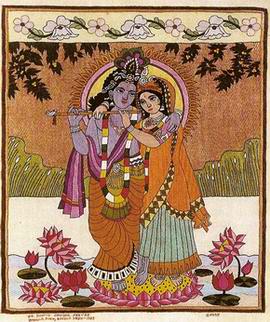Charyapada (Bangla: চর্যাপদ, Assamese: চৰ্যাপদ) are 8th-12th century CE Buddhist mystic poems from eastern India that provide early examples of Assamese,Oriya and Bengali languages. Charyapadas were also known as Charyageetis as these Padas (verses) were actuallly meant for singing. Poets of these Charyapadas, the Siddhas or Siddhacharyas belonged to the various regions of Assam, Bengal, Orissa and Bihar.
Manuscripts of Charyapada
The manuscript of Charyapada discovered by Haraprasad Shastri from Nepal consists 47 Padas (verses). The title-page, the colophon-page,the pages 36, 37, 38, 39 and 66 containing the Padas (verses) 24, 25 and 48 and their commentaries were missing in this manuscript. The 47 verses of this manuscript were written by 22 Siddhacharyas, whose names are mentioned at the beginning of each Pada (except the first Pada). Later, from the Tibetan translation of the text and its commentary we came to know about another 3 Padas, the complete form of Pada 23 and also about Siddhacharya poet Tantripāda. The names of the Siddhacharyas as mentioned at the beginning of the Padas in Sanskrit (or the Tibetan translation of it) and the Padas written by them are:
The name of another Siddhacharya poet Ladidombipāda has been mentioned by Munidatta in his commentary of Pada 10, but no Pada written by him has been discovered so far.
Probably, the Sanskrit names of the Siddhacharya poets were assigned to each Pada (verse) by the commentator Munidatta. The modern scholars doubted whether these assignments are proper on the basis of the internal evidences and other literarry sources. The controversies also exist amongst the modern scholars about the original names of these Siddhacharyas.
Language of Charyapada
Luipa, also known as Matsyendranath, was from Kamarupa and wrote two charyas. Sarahapa, another poet, is said to have been from Rani, a place close to present-day Guwahati. Some of the affinities with Assamese are:
Negatives -- the negative particle in Assamese comes ahead of the verb: na jãi (No. 2, 15, 20, 29); na jivami (No. 4); na chadaa, na jani, na disaa (No. 6). Charya 15 has 9 such forms. Present participles -- the suffix -ante is used as in Assamese of the Vaishnava period: jvante (while living, No. 22); sunante (while listening, No. 30) etc. Incomplete verb forms -- suffixes -i and -iya used in modern and old Assamese respectively: kari (3, 38); cumbi (4); maria (11); laia (28) etc. Present indefinite verb forms -- -ai: bhanai (1); tarai (5); pivai (6). Future -- the -iva suffix: haiba (5); kariba (7). Nominative case ending -- case ending in e: kumbhire khaa, core nila (2).
 Instrumental case ending -- case ending -e and -era: uju bate gela (15); kuthare chijaa (45).
Instrumental case ending -- case ending -e and -era: uju bate gela (15); kuthare chijaa (45).The vocabulary of the Charyapadas includes non-tatsama words which are typically Assamese, such as dala (1), thira kari (3, 38), tai (4), uju (15), caka (14) etc.
Affinities with Assamese
A number of Siddhacharyas who wrote the verses of Charyapada were from Bengal. Shabarpa, Kukkuripa and Bhusukupa were born in different parts of Bengal. Some of the affinities with Bengali can be found from the genitive in -era, -ara; the dative in –re; the locative in –ta; post-positional words like maajha, antara, saanga; past and future bases in –il-, -ib-; present participle in –anta; conjunctive indeclinable in –iaa; conjunctive conditional in –ite; passive in –ia- and substantive roots aach and thaak.
Affinities with Bengali
From the mention of the name of the Rāga (melody) for the each Pada at the beginning of it in the manuscript, it seems that these Padas were actually sung. All 50 Padas were set to the tunes of different Rāgas. The most common Rāga for Charyapada songs was Patamanjari.
While, some of these Rāgas are extinct, the names of some of these Rāgas may be actually the variants of the names of the popular Rāgas as we know them today.
Glimpses of social life
 Lefthit
Lefthit
No comments:
Post a Comment